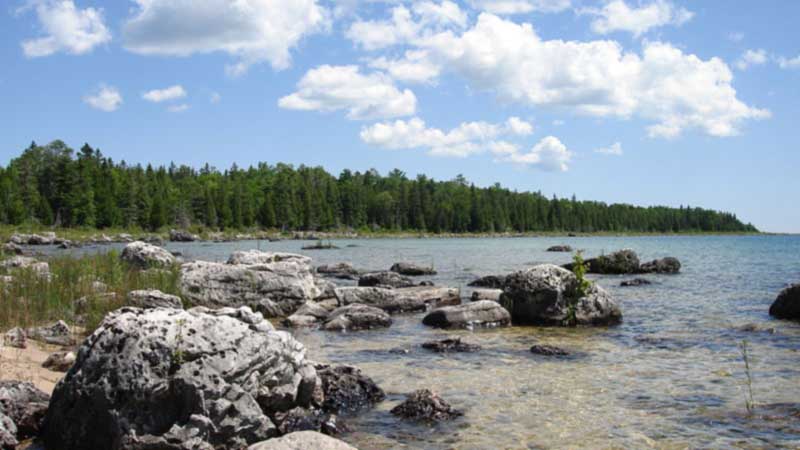Land-based stressors continue to affect the Lake Huron basin, according to joint Canada-US report
MANITOULIN – The ecosystems of Lake Huron and Lake Michigan are in fair condition, according to the 2019 State of the Great Lakes report released by the Governments of Canada and the United States. The report provides an overview of the status and trends of the Great Lakes ecosystem. Overall, the Great Lakes water quality is assessed as ‘fair and unchanging.’ Only Lake Erie’s ecosystem is in poor condition, with the trend unchanging. Lake Ontario is in fair condition with an unchanging to improving condition while Lake Superior is assessed as being in good condition with a stable trend.
Assessments help governments identify current and emerging threats and challenges to the Great Lakes and aid the evaluation of environmental policies and programs. These assessments also educate and engage the public and support continuing efforts to protect, restore and generally support the health of the Great Lakes.
There are nine indicators of ecosystem health used in the assessment: drinking water, beaches, fish consumption, toxic chemical, habitat and species, nutrients and algae, invasive species, groundwater and watershed impacts and climate trends. Over 180 government and non-government scientists worked together to assemble and prepare the report.
Progress in the restoration and protection of the lakes has occurred and includes the reduction of toxic chemicals. Current challenges include invasive species and excess nutrients that contribute to toxic and nuisance algae.
Environment and Climate Change Canada (ECCC) spokesperson Samantha Bayard said that Canada remains committed to addressing current and emerging challenges to Great Lakes water quality and ecosystem health. “Through Budget 2017, the Government of Canada invested an additional $44.84 million over five years to restore and protect Great Lakes water quality and ecosystem health via the Great Lakes Protection Initiative.”
Concentrations of toxic chemicals in Lake Huron in particular are much lower compared to the 1970s, Ms. Bayard said, but fish consumption advisories continue to be in effect. “In the south portion of Lake Huron, agricultural stressors contribute to habitat degradation. Populations of fish, as well as species of the lower food web, have remained low in the offshore waters since the mid-2000s. Phosphorus concentrations remain very low in the offshore waters. Invasive species, particularly the filter-feeding quagga mussel, are contributing to the low productivity in offshore waters and nuisance algae in some nearshore waters. The invasive sea lamprey is a continuing threat to large predator fish such as lake trout. Land-based stressors continue to impact the Lake Huron basin. Shifts in long-term climate trends, such as increasing water temperatures and decreases in ice cover, may have ecosystem implications.”
When asked if there is a strategy in place and in progress regarding the eradication of invasive species such as zebra and quagga mussels, Ms. Bayard responded, “Budget 2017 also allocated $43.8 million over five years to Fisheries and Oceans Canada to continue and expand aquatic invasive species programming in the Great Lakes, the St. Lawrence River basin and the Lake Winnipeg basin to help address threats posed by species such as Asian carp and sea lamprey.”
Cladophora is a native algae that is generally not a problem in Lake Huron but approaches nuisance levels in localized areas which coincide with points of nutrient input along the southeastern shore of Lake Huron, Ms. Bayard said. “Cladophora has not been reported to foul shorelines in Georgian Bay. Cladophora growth is influenced by temperature, sunlight and dissolved phosphorus. While management of nutrients, specifically phosphorus loading, remains an important tool for controlling Cladophora growth in the Great Lakes, the relationship between nutrient loading and Cladophora growth may have changed due to the alteration of internal nutrient dynamics by dreissenids such as zebra and quagga mussels. The resurgence of Cladophora is largely due to increased water clarity caused by the filter feeding of dreissenid mussels, with nutrient excretion by mussels also playing a role.”
“The Great Lakes Protection Initiative is a key federal program that combines science and action to address the most significant threats to Great Lakes water quality and ecosystem health,” Ms. Bayard said. “The initiative focuses on eight priorities areas including preventing toxic and nuisance algae. The Canada-Ontario Lake Erie Action Plan is a joint plan between Canada and Ontario which identifies more than 120 actions, including partner actions, to be taken over the next five years to make progress towards achieving phosphorus reduction targets for the Canadian side of Lake Erie. Zebra and quagga mussels are non-native species that have invaded the Great Lakes—both nearshore and offshore. In Lake Huron densities of mussels have become stable to slightly increasing in depths less than 90 metres, while at depths greater than 90 metres densities continue to increase. The main basin of Lake Huron generally has higher densities than Georgian Bay.”
Invasive mussels have a significant impact on the lakes by impacting nutrient cycling, increasing water clarity and altering zooplankton and phytoplankton communities, all of which have been linked to the proliferation of harmful algal blooms, nuisance algae and possibly the disappearance of the native species Diporeia, which is an important food source for fish.
In 2014, the Invasive Mussel Collaborative (IMC) was formed to advance scientifically sound technologies to control invasive mussels. The IMC includes representatives from federal, provincial, state, tribal, industry, not-for-profit and academic organizations. The 2019 Progress Report of the Parties is issued every three years to report on achievements in restoring and protecting Great Lakes water quality and ecosystem health. Progress related to various actions both binationally and domestically on invasive species and Cladophora can be found in the Progress Report of the Parties, located on www.binational.net.
The impacts of aquatic invasive species is assessed as deteriorating across all five lakes. To date, over 185 non-native aquatic species have become established in the Great Lakes basin. There has been some success in reducing the introduction of invasive species into the lakes, largely due to the implementation of regulations on ballast water from transoceanic ships. However, despite a significant slowdown in new introductions the impacts persist and population ranges continue to spread. The report notes that at least 30 percent of the aquatic non-native species found in the Great Lakes have significant environmental or socioeconomic impact.
Benchmarks for Ontario beaches are being revised to be the same as Canada guidelines which are closer to US guidelines even though Ontario has generally had higher standards in place. “Provincial standards’ and guidelines’ primary goal is for the protection of public health and safety,” Ms. Bayard explained. “Escherichia coli (E. coli) is the most appropriate indicator of faecal contamination in fresh recreational waters. Guideline values for E. coli and enterococci have been developed based on the analysis of epidemiological evidence relating concentrations of these organisms to the incidence of swimming-associated gastrointestinal illness observed among swimmers. At the provincial level in Canada, the Ontario Ministry of Health and Long-Term Care raised the provincial benchmark in January 2018. The new recreational water quality standard is a geometric mean concentration minimum of five samples of less than 200 E. coli per 100 mL, and a single-sample maximum concentration of less than 400 E. coli per 100 mL. Thereby, Canada and US E. coli standards will be similar, making the data more comparable in future binational reports.”
From 2015 through 2017, monitored Canadian Lake Huron beaches were assessed as good overall. These beaches met Ontario bacterial standards and were open and safe for swimming an average of 83 percent of the swimming season.
Groundwater can enhance surface water quality of lakes and rivers but it can also transmit contaminants and nutrients to the Great Lakes. Groundwater quality for Lake Huron is fair for areas of the basin that were assessed, the report stated. Land-based stressors will continue to impact the Lake Michigan basin. Shifts in long term climate trends such as increasing water temperatures and decreases in ice cover may have ecosystem implications.
To review the entire highlights report or for more information on Lake Huron, including threats and the state of Lake Huron, see the Lake Huron Lakewide Action and Management Plan 2017-2021 on binational.net.






